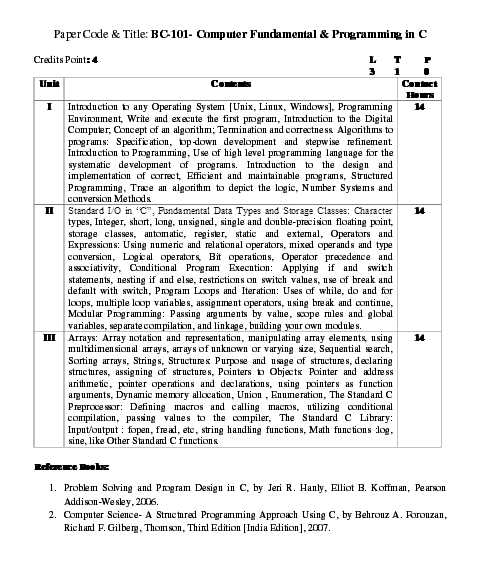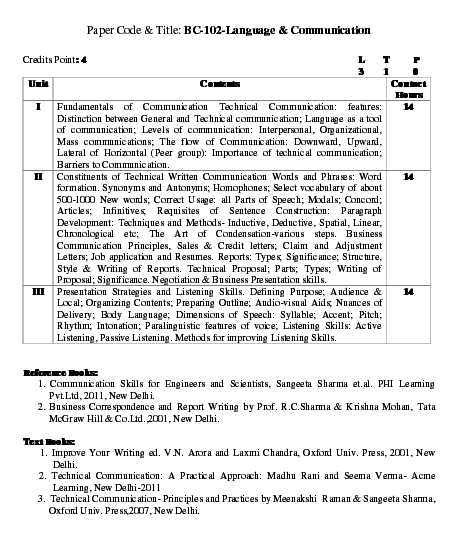|
#1
| |||
| |||
|
My sister has completed 12th class recently from CBSE Board. Now she wants to do BCA Course from Bundelkhand University. So she wants syllabus of this Course. Is there anybody who will provide syllabus of BCA Course to see all subjects?
|
|
#2
| |||
| |||
|
As you are looking to get syllabus of BCA Course offered by Bundelkhand University, so here is complete syllabus: Bundelkhand University BCA Syllabus: BC-101- Computer Fundamental & Programming in C Unit I Introduction to any Operating System [Unix, Linux, Windows], Programming Environment, Write and execute the first program, Introduction to the Digital Computer; Concept of an algorithm; Termination and correctness. Algorithms to programs: Specification, top-down development and stepwise refinement. Introduction to Programming, Use of high level programming language for the systematic development of programs. Introduction to the design and implementation of correct, Efficient and maintainable programs, Structured Programming, Trace an algorithm to depict the logic, Number Systems and conversion Methods. Unit II Standard I/O in “C”, Fundamental Data Types and Storage Classes: Character types, Integer, short, long, unsigned, single and double-precision floating point, storage classes, automatic, register, static and external, Operators and Expressions: Using numeric and relational operators, mixed operands and type conversion, Logical operators, Bit operations, Operator precedence and associativity, Conditional Program Execution: Applying if and switch statements, nesting if and else, restrictions on switch values, use of break and default with switch, Program Loops and Iteration: Uses of while, do and for loops, multiple loop variables, assignment operators, using break and continue, Modular Programming: Passing arguments by value, scope rules and global variables, separate compilation, and linkage, building your own modules. Unit III Arrays: Array notation and representation, manipulating array elements, using multidimensional arrays, arrays of unknown or varying size, Sequential search, Sorting arrays, Strings, Structures: Purpose and usage of structures, declaring structures, assigning of structures, Pointers to Objects: Pointer and address arithmetic, pointer operations and declarations, using pointers as function arguments, Dynamic memory allocation, Union , Enumeration, The Standard C Preprocessor: Defining macros and calling macros, utilizing conditional compilation, passing values to the compiler, The Standard C Library: Input/output : fopen, fread, etc, string handling functions, Math functions :log, sine, like Other Standard C functions. BC-102-Language & Communication Unit I Fundamentals of Communication Technical Communication: features: Distinction between General and Technical communication; Language as a tool of communication; Levels of communication: Interpersonal, Organizational, Mass communications; The flow of Communication: Downward, Upward, Lateral of Horizontal (Peer group): Importance of technical communication; Barriers to Communication. Unit II Constituents of Technical Written Communication Words and Phrases: Word formation. Synonyms and Antonyms; Homophones; Select vocabulary of about 500-1000 New words; Correct Usage: all Parts of Speech; Modals; Concord; Articles; Infinitives; Requisites of Sentence Construction: Paragraph Development: Techniques and Methods- Inductive, Deductive, Spatial, Linear, Chronological etc; The Art of Condensation-various steps. Business Communication Principles, Sales & Credit letters; Claim and Adjustment Letters; Job application and Resumes. Reports: Types; Significance; Structure, Style & Writing of Reports. Technical Proposal; Parts; Types; Writing of Proposal; Significance. Negotiation & Business Presentation skills. Unit III Presentation Strategies and Listening Skills. Defining Purpose; Audience & Local; Organizing Contents; Preparing Outline; Audio-visual Aids; Nuances of Delivery; Body Language; Dimensions of Speech: Syllable; Accent; Pitch; Rhythm; Intonation; Paralinguistic features of voice; Listening Skills: Active Listening, Passive Listening. Methods for improving Listening Skills. BC-103:- Computer Organization Unit I Register Transfer Language, Bus and Memory Transfers, Bus Architecture, Bus Arbitration, Arithmetic Logic, Shift Micro operation, Arithmetic Logic Shift Unit, Design of Fast address, Arithmetic Algorithms (addition, subtraction, Booth Multiplication), IEEE standard for Floating point numbers. Hardwired & Micro Programmed (Control Unit): Fundamental Concepts (Register Transfers, Performing of arithmetic or logical operations, Fetching a word from memory, storing a word in memory), Execution of a complete instruction, Multiple-Bus organization. Unit II Hardwired Control, Micro programmed control (Microinstruction, Microprogram sequencing, Wide-Branch addressing, Microinstruction with Next address field, Prefetching Microinstruction). Processor Organization: General register organization, Stack organization, Addressing mode, Instruction format, Data transfer & manipulations, Program Control, Reduced Instruction Set Computer. I/O Interface, Modes of transfer, Interrupts & Interrupt handling, Direct Memory access, Input-Output processor, Serial Communication. Unit III Memory Organization: Memory Hierarchy, Main Memory (RAM and ROM Chips), organization of 2D and 21/2D, Auxiliary memory, Cache memory, Virtual Memory, Memory management hardware. Bundelkhand University BCA Syllabus:  
__________________ Answered By StudyChaCha Member |